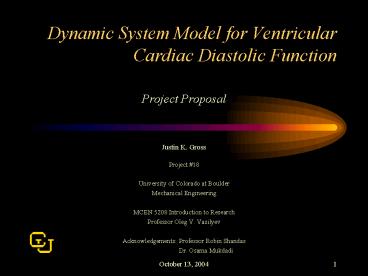Dynamic System Model for Ventricular Cardiac Diastolic Function PowerPoint PPT Presentation
Title: Dynamic System Model for Ventricular Cardiac Diastolic Function
1
Dynamic System Model for Ventricular Cardiac
Diastolic Function
- Project Proposal
- Justin K. Gross
- Project 18
- University of Colorado at Boulder
- Mechanical Engineering
- MCEN 5208 Introduction to Research
- Professor Oleg V. Vasilyev
- Acknowledgements Professor Robin Shandas
- Dr. Osama Mukdadi
2
Problem/Questions
- To develop a mechanical systems model to
characterize the normal functioning of the heart
during diastole. - To alter this model to include heart pathologies.
- Can knowledge of mechanical functioning of the
heart be used to help diagnose heart pathologies?
3
Background
- Right ventricle pumps deoxygenated blood to the
lungs - Diastolic period when ventricles relax after
systolic contraction and fill with blood - Flow through atrioventricular valves
- Cardiac pathologies changes mechanical
functioning - Clinicians look at flow across atrioventricular
valve to aid in disease detection
4
Objectives
- Model the right ventricle during diastole using a
dynamic system model - Find parameters of the system
- Understand heart functioning for healthy and
unhealthy hearts - Which mechanical parameters change
- Understand correlated physiological changes
- Develop step towards a tool for diagnosis of
heart disease
5
Methodology
- Dynamic systems model of right ventricular
diastolic function - One dimensional
- Solve inverse problem using clinically obtained
data - Blood transvalvular flow velocities
(Echocardiography) - Tissue velocities (tissue Doppler)
- Determination of parameters m, c, k using certain
assumptions - Numerical data fitting using MATLAB
- Nonlinear solver
- Levenberg-Marquardt
- Statistical analysis to validate model with
actual cardiac data
Lisauskas JB, et al.
6
Timeline
7
References
- Lisauskas JB, Singh J, Bowman AW, Kovacs SJ.
Chamber properties from transmitral flow
prediction of average and passive left
ventricular diastolic stiffness. J Appl Physiol,
91154-1622001.
PowerShow.com is a leading presentation sharing website. It has millions of presentations already uploaded and available with 1,000s more being uploaded by its users every day. Whatever your area of interest, here you’ll be able to find and view presentations you’ll love and possibly download. And, best of all, it is completely free and easy to use.
You might even have a presentation you’d like to share with others. If so, just upload it to PowerShow.com. We’ll convert it to an HTML5 slideshow that includes all the media types you’ve already added: audio, video, music, pictures, animations and transition effects. Then you can share it with your target audience as well as PowerShow.com’s millions of monthly visitors. And, again, it’s all free.
About the Developers
PowerShow.com is brought to you by CrystalGraphics, the award-winning developer and market-leading publisher of rich-media enhancement products for presentations. Our product offerings include millions of PowerPoint templates, diagrams, animated 3D characters and more.

